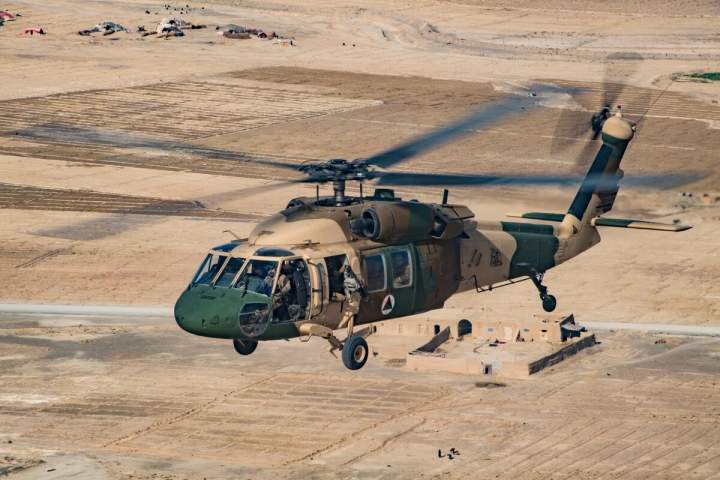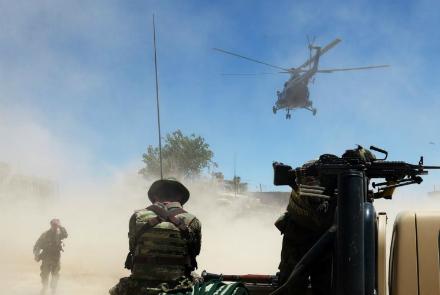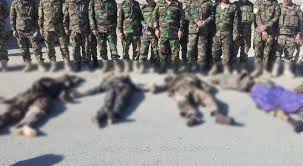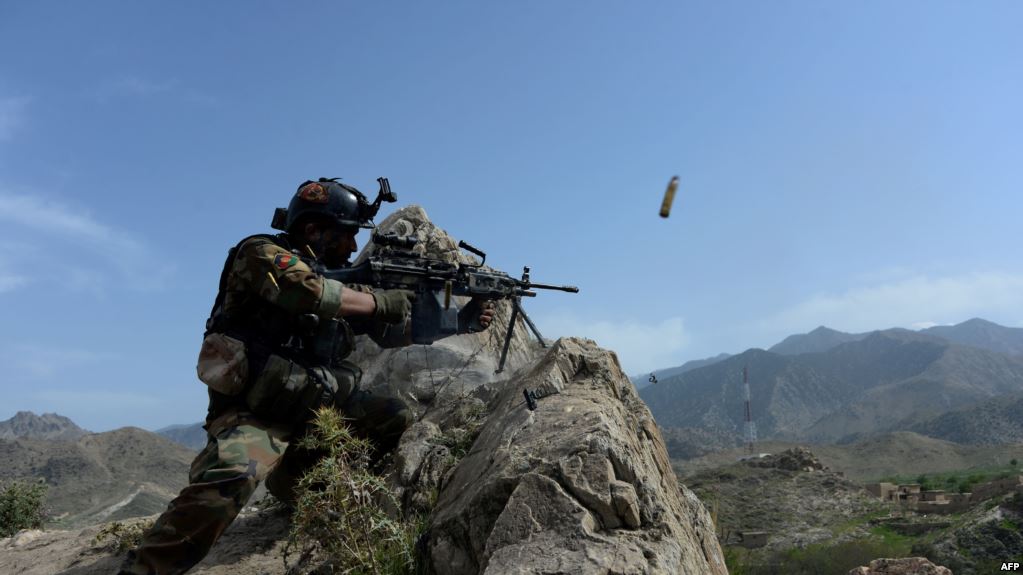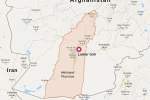The U.S. military is reducing the number of UH-60 Black Hawks it plans to provide Afghan forces from 159 to just 53 — a two-thirds cut in the quantity of rotary wing assets American forces had intended to provide, according to a Defense Department report.
Publish dateTuesday 28 January 2020 - 23:57
Story Code : 202160
In its Dec. 2019 report titled “Enhancing Security and Stability of Afghanistan” the DoD provided few details surrounding the cut to the UH-60 program, which provides Afghan forces with troop and cargo transport and casualty evacuation.
The U.S. military also cut the number of armed fixed-wing AC-208 attack and reconnaissance aircraft it originally planned to deliver from 32 to 10. AC-208 Eliminator gunships — which made its debut in Kabul in Feb. 2019 — provides ground and precision attack armed with the Advanced Precision Kill Weapon System, or APKWS rockets.
“These reductions were made on the basis of a review of future operational requirements,” the report reads.
The DoD provided no other details regarding the cuts to the UH-60 and AC-208 program. Officials from Resolute Support and the Pentagon did not immediately respond to requests for comment.
The Black Hawk program was once touted by the former commander of U.S. forces in Afghanistan Gen. John Nicholson as a game changer that would break the stalemate between Afghan and Taliban forces.
“Offensive capability is what will break the stalemate in Afghanistan,” Nicholson told lawmakers in 2017. “The key offensive capabilities for the Afghan security forces are their special forces and their Air Force.”
Success of the Afghan Air Force will be a key metric for Pentagon planners seeking to draw down U.S. troops in the country. The U.S. is still bearing most of the burden of air support for Afghan troops.
According to U.S. Air Forces Central Command, U.S. aircraft dropped 7,423 munitions in 2019 — that’s the highest number of bombs released in nearly a decade.
But critics have argued that Afghan forces are barely capable of absorbing and maintaining their existing fleet of aging Russian Mi-17 transport aircraft, among other air assets.
The Afghan military currently has 206 aircraft in its fleet with 163 of those airframes available in country, according to the DoD. Those aircraft include 45 UH-60s, 10 AC-208s, 25 A-29 Super Tucanos, 45 Mi-17s and 49 MD-530 light-attack helicopters, among other aircraft, according to the report.
“Given that it takes substantial U.S. support to maintain the airframes that the Afghan Air Force has already, it doesn’t seem feasible that they would be able to support that many Black Hawks without a significant contribution from NATO,” Matthew Archibald, an independent researcher and consultant on South Asian issues, told Military Times in 2017 following news the U.S. planned to provide 159 Black Hawks to Afghan forces.
Moreover, analysts have criticized American plans to swap out the Mi-17 with American made Black Hawk helicopters arguing that the Mi-17 provides more lift and transport capability over the UH-60. The Pentagon contends new engine upgrades would allow the Black Hawk to nearly match lift and transport capabilities of the Mi-17.
It’s unknown if the reduction in the number of UH-60s will hamper Afghan operations or limit lift capability for Afghan forces. The Black Hawk program was intended to replace Afghanistan’s aging Mi-17 fleet.
The DoD report still notes the replacement of Afghanistan’s Russian Mi-17s as a goal of the UH-60 program. “UH-60s have been fully fielded to the AAF [Afghan Air Force] and, as pilot proficiency increases, they will increasingly and fully displace the Mi-17 fleet,” the DoD report reads.
Despite the reduction in future aircraft for Afghan forces the Afghan Air Force made some positive strides in 2019.
According to the DoD report, A-29 Super Tucano light attack aircraft are conducting “now-routine delivery of laser-guided bombs” and firing APKWS rockets from AC-208s.
The report also noted that AC-208s can pair with A-29s using a laser designator aboard the AC-208 known as the MX-15 to help “buddy lase”targets or aid Super Tucanos in guiding laser guided bombs.
There are about 13,000 U.S. troops in Afghanistan. Peace negotiations between the Taliban and the U.S. are ongoing to end the 18-year long war.
The Pentagon is considering plans to reduce the U.S. footprint in Afghanistan to 8,600 troops.
The U.S. military also cut the number of armed fixed-wing AC-208 attack and reconnaissance aircraft it originally planned to deliver from 32 to 10. AC-208 Eliminator gunships — which made its debut in Kabul in Feb. 2019 — provides ground and precision attack armed with the Advanced Precision Kill Weapon System, or APKWS rockets.
“These reductions were made on the basis of a review of future operational requirements,” the report reads.
The DoD provided no other details regarding the cuts to the UH-60 and AC-208 program. Officials from Resolute Support and the Pentagon did not immediately respond to requests for comment.
The Black Hawk program was once touted by the former commander of U.S. forces in Afghanistan Gen. John Nicholson as a game changer that would break the stalemate between Afghan and Taliban forces.
“Offensive capability is what will break the stalemate in Afghanistan,” Nicholson told lawmakers in 2017. “The key offensive capabilities for the Afghan security forces are their special forces and their Air Force.”
Success of the Afghan Air Force will be a key metric for Pentagon planners seeking to draw down U.S. troops in the country. The U.S. is still bearing most of the burden of air support for Afghan troops.
According to U.S. Air Forces Central Command, U.S. aircraft dropped 7,423 munitions in 2019 — that’s the highest number of bombs released in nearly a decade.
But critics have argued that Afghan forces are barely capable of absorbing and maintaining their existing fleet of aging Russian Mi-17 transport aircraft, among other air assets.
The Afghan military currently has 206 aircraft in its fleet with 163 of those airframes available in country, according to the DoD. Those aircraft include 45 UH-60s, 10 AC-208s, 25 A-29 Super Tucanos, 45 Mi-17s and 49 MD-530 light-attack helicopters, among other aircraft, according to the report.
“Given that it takes substantial U.S. support to maintain the airframes that the Afghan Air Force has already, it doesn’t seem feasible that they would be able to support that many Black Hawks without a significant contribution from NATO,” Matthew Archibald, an independent researcher and consultant on South Asian issues, told Military Times in 2017 following news the U.S. planned to provide 159 Black Hawks to Afghan forces.
Moreover, analysts have criticized American plans to swap out the Mi-17 with American made Black Hawk helicopters arguing that the Mi-17 provides more lift and transport capability over the UH-60. The Pentagon contends new engine upgrades would allow the Black Hawk to nearly match lift and transport capabilities of the Mi-17.
It’s unknown if the reduction in the number of UH-60s will hamper Afghan operations or limit lift capability for Afghan forces. The Black Hawk program was intended to replace Afghanistan’s aging Mi-17 fleet.
The DoD report still notes the replacement of Afghanistan’s Russian Mi-17s as a goal of the UH-60 program. “UH-60s have been fully fielded to the AAF [Afghan Air Force] and, as pilot proficiency increases, they will increasingly and fully displace the Mi-17 fleet,” the DoD report reads.
Despite the reduction in future aircraft for Afghan forces the Afghan Air Force made some positive strides in 2019.
According to the DoD report, A-29 Super Tucano light attack aircraft are conducting “now-routine delivery of laser-guided bombs” and firing APKWS rockets from AC-208s.
The report also noted that AC-208s can pair with A-29s using a laser designator aboard the AC-208 known as the MX-15 to help “buddy lase”targets or aid Super Tucanos in guiding laser guided bombs.
There are about 13,000 U.S. troops in Afghanistan. Peace negotiations between the Taliban and the U.S. are ongoing to end the 18-year long war.
The Pentagon is considering plans to reduce the U.S. footprint in Afghanistan to 8,600 troops.
avapress.net/vdcaiunuw49nw61.tgk4.html
Tags
Top hits
